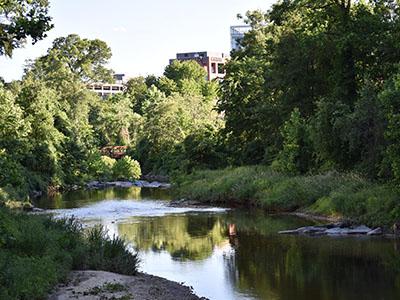Water & Sustainability

Facilities Management (FM) has integrated sustainable water management into our standard operating procedures. FM teams monitor water use to locate and repair underground leaks before too much water is wasted. As part of the planning process for green buildings, FM's Planning and Construction unit specifies fixtures that maximize water conservation.
Stormwater management is a key element in FM's approach to water and sustainability. Our goal in management of stormwater is to reduce runoff and improve the quality of water runoff that remains into area streams and rivers. The result is less erosion, flooding and pollution.
Stormwater management on the College Park campus uses several tools, among them green roofs, bioretention facilities, rain gardens, and permeable pavement. The intent of these installations is to mimic the original natural environment. As Stormwater Manager Michael Carmichael describes it, “We are managing our stormwater on site - not letting it run off and become someone else’s problem.”
FM depends in part on reports from UMD students, staff and faculty to discover potential problems. To report a problem, contact Michael Carmichael.
Campus Creek Restoration Project
A recent example of active stormwater management is the Campus Creek restoration project. Designed to address stormwater runoff and erosion within the creek, the project was completed by FM in November 2019. After 10 years of planning, the project was funded in large part by grants from Maryland DNR and the UMD Sustainability Fund. The project restored more than 3000 feet of the creek, starting behind Oakland Hall, and extending to the east side of the School of Public Health. As part of this effort, more than 700 native trees were planted within the creek corridor.
A series of step pools were created to slow the water’s movement through the creek bed, preventing erosion using a technique known as Regenerative Stream Conveyance (RSC). These pools slow the water flowing through the creek, reducing flooding, erosion and sedimentation, meaning less muddy waters. In certain parts of the stream, water flows into flood plains during heavy rain. This mimics naturally occurring wetland habitats found in the area. The flood plains are low-lying, shallow areas adjacent to the creek, designed to receive water during heavy rains, then recede. This wet/dry cycle creates a unique habitat that sustains the life of a number of native plants and animals.
407 acres drain into the restored section of the creek, and account for 105 acres of paved (or impervious) area. Of the 1340 acres of the UMD campus, 454 acres are impervious: roadways, parking lots, rooftops, and sidewalks. These impervious areas prevent stormwater from soaking into the ground, and create runoff that spurs erosion, pollution, and harms the health of our waterways and the species that call them home. Stormwater regulations require the University to treat at least 20% of our existing impervious area, which equals approximately 91 acres. So the Campus Creek Restoration goes well beyond our requirement for impervious runoff treatment!
